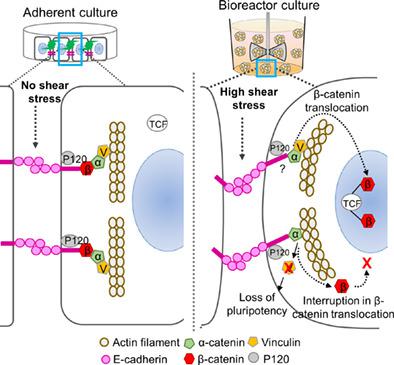当前位置:
X-MOL 学术
›
STEM CELLS
›
论文详情
Our official English website, www.x-mol.net, welcomes your feedback! (Note: you will need to create a separate account there.)
Fluid shear stress promotes embryonic stem cell pluripotency via interplay between β-catenin and vinculin in bioreactor culture
STEM CELLS ( IF 5.2 ) Pub Date : 2021-04-09 , DOI: 10.1002/stem.3382 Suman C Nath 1, 2 , Bradley Day 1 , Lane Harper 1 , Jeffrey Yee 1 , Charlie Yu-Ming Hsu 1 , Leila Larijani 2, 3 , Leili Rohani 1 , Nicholas Duan 1 , Michael S Kallos 2, 4, 5 , Derrick E Rancourt 1, 2, 3
STEM CELLS ( IF 5.2 ) Pub Date : 2021-04-09 , DOI: 10.1002/stem.3382 Suman C Nath 1, 2 , Bradley Day 1 , Lane Harper 1 , Jeffrey Yee 1 , Charlie Yu-Ming Hsu 1 , Leila Larijani 2, 3 , Leili Rohani 1 , Nicholas Duan 1 , Michael S Kallos 2, 4, 5 , Derrick E Rancourt 1, 2, 3
Affiliation

|
The expansion of pluripotent stem cells (PSCs) as aggregates in stirred suspension bioreactors is garnering attention as an alternative to adherent culture. However, the hydrodynamic environment in the bioreactor can modulate PSC behavior, pluripotency and differentiation potential in ways that need to be well understood. In this study, we investigated how murine embryonic stem cells (mESCs) sense fluid shear stress and modulate a noncanonical Wnt signaling response to promote pluripotency. mESCs showed higher expression of pluripotency marker genes, Oct4, Sox2, and Nanog in the absence of leukemia inhibitory factor (LIF) in stirred suspension bioreactors compared to adherent culture, a phenomenon we have termed mechanopluripotency. In bioreactor culture, fluid shear promoted the nuclear translocation of the less well-known pluripotency regulator β-catenin and concomitant increase of c-Myc expression, an upstream regulator of Oct4, Sox2, and Nanog. We also observed similar β-catenin nuclear translocation in LIF-free mESCs cultured on E-cadherin substrate under defined fluid shear stress conditions in flow chamber plates. mESCs showed lower shear-induced expression of pluripotency marker genes when β-catenin was inhibited, suggesting that β-catenin signaling is crucial to mESC mechanopluripotency. Key to this process is vinculin, which is known to rearrange and associate more strongly with adherens junctions in response to fluid shear. When the vinculin gene is disrupted, we observe that nuclear β-catenin translocation and mechanopluripotency are abrogated. Our results indicate that mechanotransduction through the adherens junction complex is important for mESC pluripotency maintenance.
中文翻译:

流体剪切应力通过生物反应器培养中β-连环蛋白和纽蛋白之间的相互作用促进胚胎干细胞多能性
多能干细胞 (PSC) 作为在搅拌悬浮生物反应器中的聚集体的扩增作为贴壁培养的替代品而受到关注。然而,生物反应器中的流体动力学环境可以以需要充分理解的方式调节 PSC 行为、多能性和分化潜能。在这项研究中,我们研究了鼠胚胎干细胞 (mESCs) 如何感知流体剪切应力并调节非经典 Wnt 信号传导反应以促进多能性。与贴壁培养相比,在没有白血病抑制因子 (LIF) 的情况下,mESCs 在搅拌悬浮生物反应器中表现出更高的多能性标记基因 Oct4、Sox2 和 Nanog 表达,我们将这种现象称为机械多能性。在生物反应器培养中,流体剪切促进了鲜为人知的多能性调节因子 β-连环蛋白的核转位,并伴随增加了 c-Myc 表达,后者是 Oct4、Sox2 和 Nanog 的上游调节因子。我们还在流动室板中定义的流体剪切应力条件下在 E-钙粘蛋白底物上培养的无 LIF 的 mESC 中观察到类似的 β-连环蛋白核易位。当 β-catenin 被抑制时,mESCs 表现出较低的剪切诱导的多能性标记基因表达,这表明 β-catenin 信号传导对 mESC 机械多能性至关重要。这个过程的关键是纽蛋白,已知它会重新排列并更强烈地与黏附连接处相关联,以响应流体剪切。当 vinculin 基因被破坏时,我们观察到核 β-连环蛋白易位和机械多能性被废除。
更新日期:2021-04-09
中文翻译:

流体剪切应力通过生物反应器培养中β-连环蛋白和纽蛋白之间的相互作用促进胚胎干细胞多能性
多能干细胞 (PSC) 作为在搅拌悬浮生物反应器中的聚集体的扩增作为贴壁培养的替代品而受到关注。然而,生物反应器中的流体动力学环境可以以需要充分理解的方式调节 PSC 行为、多能性和分化潜能。在这项研究中,我们研究了鼠胚胎干细胞 (mESCs) 如何感知流体剪切应力并调节非经典 Wnt 信号传导反应以促进多能性。与贴壁培养相比,在没有白血病抑制因子 (LIF) 的情况下,mESCs 在搅拌悬浮生物反应器中表现出更高的多能性标记基因 Oct4、Sox2 和 Nanog 表达,我们将这种现象称为机械多能性。在生物反应器培养中,流体剪切促进了鲜为人知的多能性调节因子 β-连环蛋白的核转位,并伴随增加了 c-Myc 表达,后者是 Oct4、Sox2 和 Nanog 的上游调节因子。我们还在流动室板中定义的流体剪切应力条件下在 E-钙粘蛋白底物上培养的无 LIF 的 mESC 中观察到类似的 β-连环蛋白核易位。当 β-catenin 被抑制时,mESCs 表现出较低的剪切诱导的多能性标记基因表达,这表明 β-catenin 信号传导对 mESC 机械多能性至关重要。这个过程的关键是纽蛋白,已知它会重新排列并更强烈地与黏附连接处相关联,以响应流体剪切。当 vinculin 基因被破坏时,我们观察到核 β-连环蛋白易位和机械多能性被废除。



























 京公网安备 11010802027423号
京公网安备 11010802027423号